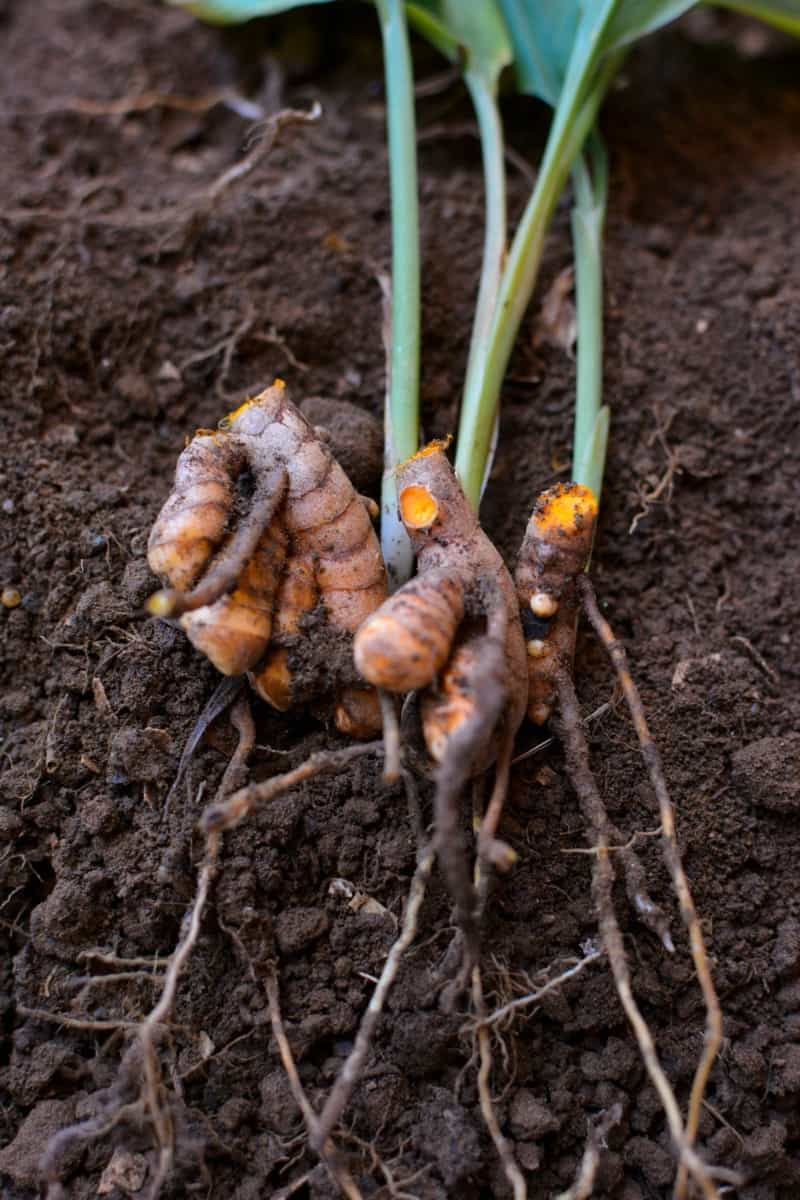Pests can significantly affect the growth and health of Turmeric plants. These pesky critters can cause damage to both the foliage and the rhizomes, making it important for growers to take proactive measures to control them naturally. The main pest that affects Turmeric is rhizome rot, which causes the roots and rhizomes of the plant to decay, leading to stunted growth and yellowing leaves. Another troublesome pest is leaf spot, characterized by dark brown or black spots on the leaves.

This can reduce photosynthesis and weaken the overall health of the plant. Leaf blotch is similar, causing irregularly shaped lesions on the foliage. Thrips are tiny insects that pierce through leaves and suck out cell contents. They cause discoloration, deformation, and curling of affected leaves. Lacewing bugs may also be found in Turmeric gardens; while they mainly feed on other pests like aphids or caterpillars, they sometimes damage Turmeric foliage.
How to Control Turmeric Pests Naturally
Creating a Pest-Resistant Environment for Turmeric: Tips and Techniques
An effective pest-resistant technique in Turmeric is practicing crop rotation. Avoid planting Turmeric in the same spot year after year. Remove any dead plant material promptly, which can attract pests. Regularly weed your garden beds to eliminate hiding places for insects. Proper spacing between plants also allows for better airflow and reduces the risk of disease transmission. Consider using organic mulch around your Turmeric plants. Mulch helps retain soil moisture and is a barrier against crawling pests like slugs and snails.
Soil Management Strategies for Reducing Turmeric Pest Populations
Soil management plays a crucial role in reducing Turmeric pest populations and ensuring the overall health of your plants. An important aspect of soil management is maintaining proper drainage. Another strategy is practicing crop rotation. Avoid planting Turmeric in the same spot year after year, as this can cause pests and diseases in the soil.
Instead, rotate with other crops like legumes or leafy greens, which help break pest cycles and replenish nutrients. Furthermore, regularly monitoring the pH levels of your soil is essential. Turmeric prefers slightly acidic conditions (pH 6-7).
Companion Planting for Natural Pest Control in Turmeric Gardens
Marigolds – Marigolds add beauty to your garden with their vibrant colors and are a natural deterrent for many common pests. Their strong scent repels insects like aphids, nematodes, and whiteflies.
Basil has a strong aroma that can confuse and deter pests such as thrips and mites. Plus, it adds flavor to your dishes when harvested!
In case you missed it: How to Control Dahlia Pests Naturally: How to Get Rid of Them with Natural and Organic Treatment

Mint – Mint is another beneficial companion plant for controlling pests in the Turmeric garden. Its pungent smell repels ants, aphids, and flea beetles.
Lavender – It is also known to repel many unwanted insects while attracting beneficial pollinators like bees and butterflies.
Introducing Beneficial Insects to Combat Turmeric Pests
Ladybugs are one example of beneficial insects that can be introduced to combat common Turmeric pests such as aphids and thrips. Another beneficial insect is the praying mantis. Praying mantises are voracious predators that will eat various garden pests, including caterpillars, beetles, and grasshoppers. Plant flowers like marigolds and daisies alongside your Turmeric plants to attract these beneficial insects to your garden. These flowers provide nectar for the adult insects and serve as a food source for their larvae.
Homemade Organic Sprays for Controlling Turmeric Pests
The main homemade organic spray for controlling Turmeric is a mixture of neem oil and water. Neem oil has insecticidal properties that can help control many pests, such as thrips and leaf spot. Mix neem oil with water, shake well, and spray it onto the affected plants. Garlic is another organic pest control for Turmeric. It has natural pesticidal properties that repel pests like aphids and spider mites. To make garlic spray, crush several garlic cloves and soak them in hot water overnight. Strain the mixture into a bottle and apply it to your Turmeric plants.
Using Physical Barriers to Protect Turmeric from Pests
The physical barrier to protect Turmeric from pests is using row covers, lightweight fabrics that can be placed directly over the plants. These covers create a barrier between the Turmeric and pests, preventing them from accessing the plants. Using netting or mesh screens around your Turmeric Garden helps control pests.
This helps to keep out larger pests, such as birds or rodents, that may be attracted to your crop. Mulching is also a great way to create a physical barrier for your Turmeric. Applying an organic mulch layer around each plant’s base can deter pests from reaching the roots and causing damage.
Implementing Cultural Practices to Prevent Pest Infestations in Turmeric
Proper sanitation is essential to prevent Turmeric pests. Remove plant debris or fallen leaves regularly to eliminate potential hiding places for pests. This will discourage them from taking up residence near your Turmeric plants. Another practice to consider is intercropping with companion plants that repel common Turmeric pests. Furthermore, good weed management can significantly reduce pest pressure on your Turmeric. Weeds often serve as hosts for various insects and diseases that may attack your crops.
In case you missed it: How to Control Ginger Pests Naturally: How to Get Rid of Them with Natural and Organic Treatment

Natural Predators of Turmeric Pests: Encouraging Wildlife in the Garden
Ladybugs are voracious eaters of aphids, which can be a common problem in Turmeric gardens. By attracting ladybugs to your garden, you’ll have a built-in pest control system that will help protect your precious plants. The lacewing bug is a tiny insect that feeds on smaller pests like thrips and mites, which can wreak havoc on Turmeric if left unchecked. Creating an inviting habitat for lacewings with plenty of flowering plants and sheltered areas can encourage them to reside in your garden.
Monitoring and Early Detection: Key Steps in Managing Turmeric Pests Naturally
The main aspect of monitoring is to look for any physical symptoms or damage caused by pests. For example, check the leaves for discoloration, holes, or chewed edges. Examine the rhizomes for rotting or decay. Pay attention to the presence of eggs or larvae on the plant surfaces. These visual cues can provide valuable information about which pests may be present. Regularly monitor weather conditions since some pests thrive under certain conditions. High humidity and excessive moisture can contribute to rhizome rot and leaf spot diseases.
Frequently Asked Questions about Control Turmeric Pests Naturally
How Do You Remove Pests from Turmeric?
You can use natural methods to remove pests from Turmeric, such as handpicking them off the plants or spraying them with neem oil or garlic spray.
What Is the Best Pesticide for Turmeric?
Instead of relying on chemical pesticides, it’s recommended to use organic alternatives like neem oil, insecticidal soap, or botanical extracts that are safe for the environment and your health.
What Types of Pests Can Affect Turmeric Plants?
Various pests can affect turmeric plants, including rhizome rot, leaf spot, leaf blotch, shoot borers, thrips, lacewing bugs, skipper butterflies, and rhizome maggots.
How do You Control Thrips in Turmeric?
To control thrips in Turmeric, you can release beneficial insects like lacewing bugs or ladybugs into your garden to prey upon them. Additionally, practicing good crop rotation and removing infected plant debris can help reduce their population.
Can I Use Homemade Sprays to Control Pests in My Turmeric?
Yes. Homemade organic sprays for controlling Turmeric pests made with ingredients like chili pepper, garlic, or onion can effectively deter plant pests without harming beneficial insects or pollinators.
In case you missed it: How to Control Garlic Pests Naturally: How to Get Rid of Them with Natural and Organic Treatment

Control Turmeric Pests Naturally
| Pests | Symptoms | Identification | Natural Control |
| Rhizome rot | Yellowing of leaves; decayed rhizomes | Examination of affected rhizomes | Crop rotation; proper drainage |
| Leaf spot | Small brown or black spots on leaves | Visual inspection | Neem oil spray; remove infected foliage |
| Leaf blotch | Large irregular dark spots on leaves | Present a scorched appearance | Copper-based fungicides improve air circulation |
| Rhizome scale | Yellowing leaves | Inspect rhizomes | Apply neem oil or insecticidal soap |
| Thrips | Silver streaks on leaves | Very small, have elongated abdomens | Use sticky traps or introduce predatory insects |
Conclusion
Turmeric pests cause damage to your precious plants and hinder their growth. Natural pest control methods eliminate the need for harsh chemicals and pesticides, ensuring a safer environment for you and your plants. Identifying common pest causes in Turmeric is crucial for effective management. By implementing these natural methods for controlling Turmeric pests, you can ensure the plant’s health and productivity without relying on harmful chemicals.
- Deworming Schedule for Dogs/Puppies: A Beginners Guide
- How to Prevent and Control Parasites in Goats
- Beneficial Insects in Pest Management
- Natural Solutions for Pest Control in Flower Gardens
- Types of Fungicides Used in Agriculture
- Common Issues in the Fruit Development Stage of Pomegranate Farming
- Fruit Development Issues in Papaya: Easy Solutions and Treatment
- Soil-Borne Diseases and How to Protect Your Plants
- Practices to Prevent Disease Spread in the Garden